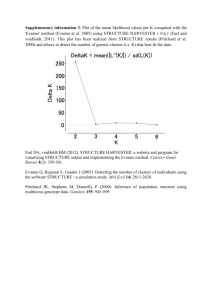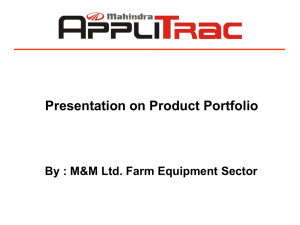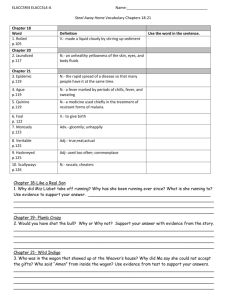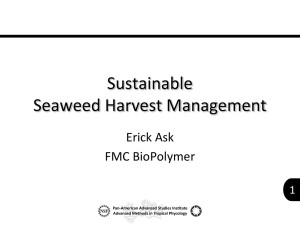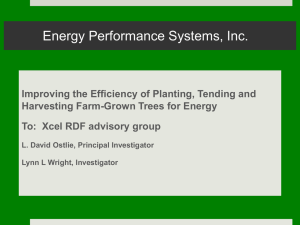Burley Machines Overview - Biosystems & Agricultural Engineering
advertisement
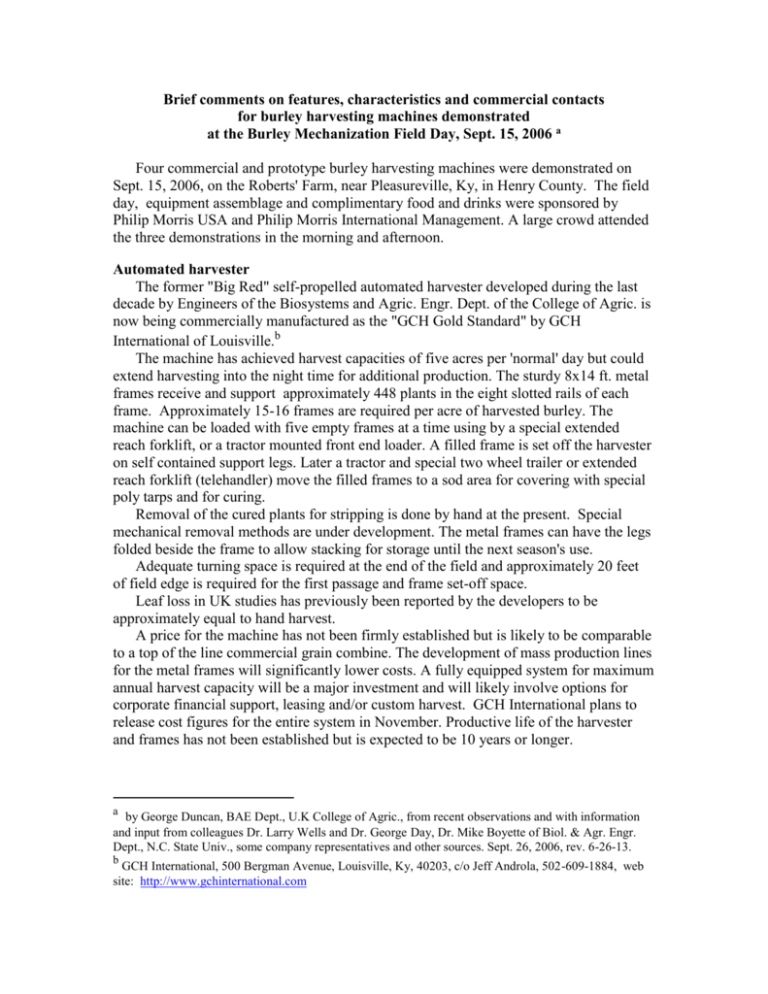
Brief comments on features, characteristics and commercial contacts for burley harvesting machines demonstrated at the Burley Mechanization Field Day, Sept. 15, 2006 a Four commercial and prototype burley harvesting machines were demonstrated on Sept. 15, 2006, on the Roberts' Farm, near Pleasureville, Ky, in Henry County. The field day, equipment assemblage and complimentary food and drinks were sponsored by Philip Morris USA and Philip Morris International Management. A large crowd attended the three demonstrations in the morning and afternoon. Automated harvester The former "Big Red" self-propelled automated harvester developed during the last decade by Engineers of the Biosystems and Agric. Engr. Dept. of the College of Agric. is now being commercially manufactured as the "GCH Gold Standard" by GCH International of Louisville.b The machine has achieved harvest capacities of five acres per 'normal' day but could extend harvesting into the night time for additional production. The sturdy 8x14 ft. metal frames receive and support approximately 448 plants in the eight slotted rails of each frame. Approximately 15-16 frames are required per acre of harvested burley. The machine can be loaded with five empty frames at a time using by a special extended reach forklift, or a tractor mounted front end loader. A filled frame is set off the harvester on self contained support legs. Later a tractor and special two wheel trailer or extended reach forklift (telehandler) move the filled frames to a sod area for covering with special poly tarps and for curing. Removal of the cured plants for stripping is done by hand at the present. Special mechanical removal methods are under development. The metal frames can have the legs folded beside the frame to allow stacking for storage until the next season's use. Adequate turning space is required at the end of the field and approximately 20 feet of field edge is required for the first passage and frame set-off space. Leaf loss in UK studies has previously been reported by the developers to be approximately equal to hand harvest. A price for the machine has not been firmly established but is likely to be comparable to a top of the line commercial grain combine. The development of mass production lines for the metal frames will significantly lower costs. A fully equipped system for maximum annual harvest capacity will be a major investment and will likely involve options for corporate financial support, leasing and/or custom harvest. GCH International plans to release cost figures for the entire system in November. Productive life of the harvester and frames has not been established but is expected to be 10 years or longer. a by George Duncan, BAE Dept., U.K College of Agric., from recent observations and with information and input from colleagues Dr. Larry Wells and Dr. George Day, Dr. Mike Boyette of Biol. & Agr. Engr. Dept., N.C. State Univ., some company representatives and other sources. Sept. 26, 2006, rev. 6-26-13. b GCH International, 500 Bergman Avenue, Louisville, Ky, 40203, c/o Jeff Androla, 502-609-1884, web site: http://www.gchinternational.com Kirpy Harvester A unique tractor mounted and powered machine has evolved over the last 10-15 years from a French manufacturerc. The 'Kirpy' harvester has a 'log chain' type conveyor with small spike-laden metal plates attached to alternate links. The spikes penetrate and convey plants through numerous curves with a back side guide to get plants from a standing position to elevating them up, around and depositing them horizontally onto a flat bed wagon or similar transport vehicle pulled along side the harvester. The machine is three-point hitch mounted and powered by a PTO shaft to the hydraulic pump system. Approximately 10-15 have been sold in the U.S. this year in various parts of the traditional and expanding burley production belt. Over 500 are reported in use in France. A special requirement experienced by the trial users in the U.S. is that the tractor must have a very slow 'creeper' ground drive (0.6 to 1.0 mph) while running the PTO at near 540 rpm for proper hydraulic flow and pressure. A saw mechanism cuts the 45 degree notch near the base of the plant during the conveying movement. Several observations show the plants need to be properly and erectly conveyed by the chain to receive a suitable notch. Plants are deposited onto the wagon, either shingled from front to rear or all piled along the bed, as controlled by the movement of the wagon tractor driver. A normal farm wagon is soon filled with the loosely stacked plants, usually in 400-500 feet of row length. Some growers in other states are using 40 ft 'cotton trailers' for greater capacity but turning and alignment at the row end may require more space. The machine and accompanying wagon are stopped at the end of each row so the conveyor can be emptied of plants in preparation for turning and getting re-aligned for the next row. Adequate turning space is required at the end of the field for the accompanying wagon. Approximately 20-25 feet of field edge is required for the first passage of the equipment. Blocks of rows and drive-way space need to be planned, or cut by hand, to minimize end of field travel and non productive harvest time. One field trial in another state on very sloping and uneven terrain showed difficulty in keeping the cutting head on the row. Further cutting was not continued. While no definite study has yet been done and reported on performance and leaf loss (later studies have reported operational data), it is obvious that at least three tractor and wagons units with at least two drivers will be needed to shuttle wagons back and forth from field to hanging structure. The leaf breakage from piling the plants and removing them appears to be somewhat greater than normal manual harvest depending on the condition of the tobacco and worker care in removing plants from the wagon load. Reports from another state indicate several of the farmers actually let the plants fall to the ground to get field wilt for a few hours, then had the workers pick up the plants and spike them onto sticks for housing or load the individual plants onto wagons and trailers for transport to the wire structures. Less breakage and leaf loss was claimed with this process even though additional labor was required. Additionally, timed data projections and limited on-farm operations show 8-10 workers are needed at the high tensile wire frame work to unload the wagons to maintain c Note 6/2013: Former U.S. Distributor no longer in business. Source in U.S. unknown at present. Kirpy web site: http://www.kirpy.com/en/cadre_EN.html and check Harvester continuous harvester operation. Thus, a 'crew' of 11-13 workers will likely be needed to harvest approximately 2.0-2.5 acres per day. An advantage of this method, as acclaimed by several operators, is that the workers are only handling one plant at a time and can have a different skill and physical capability than handling a stick at a time, especially up into a barn. Various hurriedly built high tensile wire field frameworks are being used this season for hanging the plants. Some have shown partial breakdowns with the heavy tobacco. All have some form of plastic cover to protect the tobacco from rain during the cure (if applied before rains). Operational life of the machine is not known at present although the developer of the machine responded personally to me that the chain has an expected life of 1.0 to 1.5 million plants (approx. 140 to 214 acres). Use with the large U.S. plants requires proper adjustment of the chain guides else rapid wear of a sprocket has been experienced. Whether it is feasible to cut tobacco with this machine and then spear the plants onto sticks at the barn is being discussed and maybe tried by a grower or two. A pipe frame trailer or another wagon seems necessary to load the load the stick tobacco onto before moving into the barn housing position, thus another handling operation and extra labor requirement but it does utilize existing barn space. Stretching more than one level of wires in a barn has not proven feasible. The Kirpy machine was being marketed by a U.S. Distributor at a quoted price of around $23,000 fob distributor with some variations possibly due to money exchange rates, shipping and final delivery prep and setup costs. MarCo Harvester A plant notching harvester was being built by MarCo Manufacturing Co. LLC d of Bennettsville, SC. It was a smaller version of the former Powell burley harvesting machine without the portable rack handling and filling mechanisms. It is a tractor mounted 3-point hitch machine that cuts, notches and conveys the plants via a 4 ft wide belt onto a wagon pulled along side the tractor and machine. It seems to operate at a speed more like 1.5 to 2.0 mph. Three machines were built for the 2006 harvest season. Plant orientation is somewhat erratic going onto the wagon. Further adjustments to devices to align the plants on the wide belt will improve the plant placement on the wagon and avoid extra manual effort to ensure good plant flow. A normal farm wagon can be filled quickly with the loosely stacked plants, usually in 400-500 feet of row length. The machine and accompanying wagon is stopped at the end of each row so the conveyor can be emptied of plants in preparation for turning and getting re-aligned for the next row. Adequate turning space is required at the end of the field for the accompanying wagon and approximately 20-25 feet of field edge is required for the first passage of the equipment. Blocks of rows and drive-way space need to be planned, or cut by hand, to minimize end of field travel and minimize non productive harvest time. While no definite study has been done and reported as of the field day (later studies have been done and reported), it is obvious that at least three tractor and wagons units d MarCo Manufacturing Co., LLC., P.O. Box 1012, Bennettsville, SC., 29512, Ph: 843-479-5060, c/o Tom Pharr, web site: http://www.marcomfgllc.com with at least two drivers to shuttle wagons will be needed to keep moving the tobacco from the harvester to the field curing framework to get maximum productivity of the harvester of approximately 2.0 to 2.5 acres per normal day. Additionally, initial timed data projections and practical on-farm operations show 8-10 workers are needed at the high tensile wire frame work to unload the wagons to maintain continuous harvester operation. Thus, a total 'crew' of 11-13 workers to harvest 2.0 acres or more per day. An advantage of this method is that the workers are only handling one plant at a time and can be a different skill and physical capability than handling a stick at a time, especially up into a barn. Various high tensile wire field frameworks are being used this season for hanging the plants. All have some form of plastic cover to protect the tobacco from rain during the cure. The leaf breakage from piling the plants and removing them appears to be somewhat greater than normal manual harvest depending on the crop conditions. Operational life of the machine is not known at present but the former Powell machine was operated by several growers for 30-40 acres per year for 4-5 years with reasonable maintenance. The current model 6026 machine was quoted at $27,500 fob factory with complete assembly and testing prior to shipping. On site setup to get field ready in stated as less than two hours. Prototype U. Ky. Rail Harvester A newer mechanical system for harvesting burley was displayed and is under development at the University of Kentucky Department of Biosystems and Agricultural Engineering. The system employs methods which have been developed and proven in a fully automated harvesting system that has recently been made commercially available to burley growers. The new experimental system employs a tractor-drawn harvester that detaches, conveys, inverts and notches whole burley plants. Notched plants are inserted into slotted steel rails, 10 feet long, holding 40 plants each. Ten filled rails are unloaded onthe-go simultaneously by the harvester onto the ground. The harvester can hold nearly 200 empty rails, enough to harvest approximately 1.1 acre. A tractor-drawn retriever/transporter picks up the ten-rail ‘loads’ and transports them to field curing structures. The rails are unloaded upon and supported by such structures. Tobacco on the structures is left exposed for approximately one week (if no rain) and then covered with waterproof material. Research has indicated that excellent curing can be achieved in 5 to 6 weeks. Future work is planned to investigate placement of filled steel rails into modified conventional curing barns. A prototype harvester is being tested during 2006 and results will be available after harvesting is completed. Preliminary estimates of a harvesting speed of 1 plant per second and a field efficiency of 60% would result in an approximate harvesting capacity of 0.3 acres per hour for two workers. Prototype Burley Stripping Machine A prototype burley stripping machine was on static display but details of operation were limited. Further development is underway in anticipation of on-farm trials later in the fall. *** end ***

